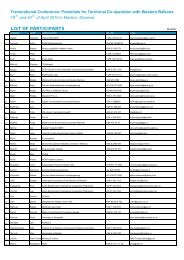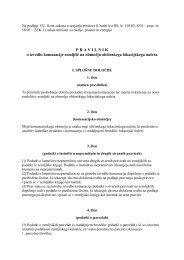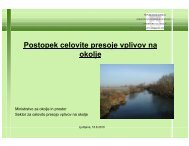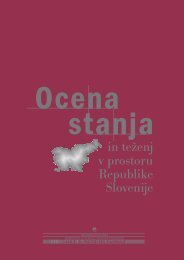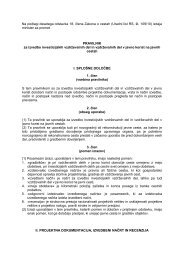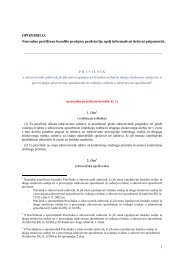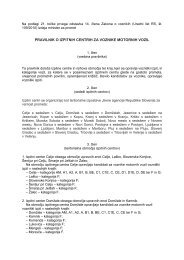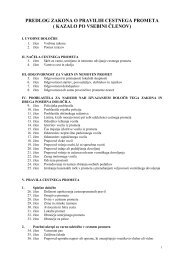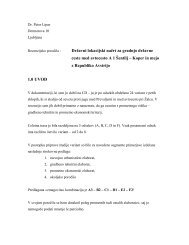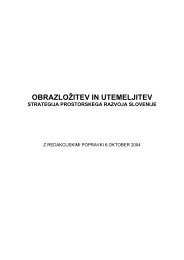evropska konvencija o krajini - Ministrstvo za infrastrukturo in prostor
evropska konvencija o krajini - Ministrstvo za infrastrukturo in prostor
evropska konvencija o krajini - Ministrstvo za infrastrukturo in prostor
Create successful ePaper yourself
Turn your PDF publications into a flip-book with our unique Google optimized e-Paper software.
242Delavnica 3 / Workshop 3turistična območja s počitniškimi objekti - jerelativno eksogena narava nove <strong>in</strong>frastrukture, kije bila umeščena v kraj<strong>in</strong>o, ne da bi se splohkakor koli pomislilo na različne procese razvoja<strong>in</strong> reorgani<strong>za</strong>cije gospodarstva, ali na kraj<strong>in</strong>o,preko katere poteka.Gledano izven ozkega pogleda tehnike, je programnenehnih <strong>in</strong>frastrukturnih del, ki se danespredlagajo <strong>za</strong> našo državo po obdobju največjemožne ponovne uporabe <strong>in</strong> <strong>in</strong>terpretacijepodedovanih <strong>in</strong>frastruktur <strong>in</strong> družbenegakapitala, lahko ne le bistveni element odziva nareorgani<strong>za</strong>cijo družbeno-ekonomskega razvojapove<strong>za</strong>v znotraj <strong>in</strong> izven urbanih, <strong>in</strong>dustrijskih,turističnih ali podeželskih območij naše države,temveč tudi temeljno orodje pri izboljšanjukraj<strong>in</strong>e.Razlogi, ki podpirajo to tezo, so različni. Kot prvo,ker mora program obravnavati sistem takonaravnih kot ustvarjenih odprtih <strong>prostor</strong>ov, ki soznačilni <strong>za</strong> okolje: z drugimi besedami, prev<strong>za</strong>melahko pomembno vlogo (bodisi pozitivno al<strong>in</strong>egativno) pri utrjevanju novih oblikurbaniziranih območij, novih okoljskih sistemov,ki morajo upoštevati večjo rabo ozemlja <strong>in</strong> večjomobilnost. Kot drugo, politika ponovnegarazvoja tako obstoječih kot novih <strong>in</strong>frastrukturnihobjektov neizogibno vključuje reorgani<strong>za</strong>cijosuburbaniziranih območij, ki bi jo lahko do nekemere usmerjala politika <strong>za</strong>vedanja kraj<strong>in</strong>e <strong>in</strong><strong>prostor</strong>a z vidika potreb po nastanitvi <strong>in</strong> skupnihdejavnostih (javnih, rekreativnih <strong>in</strong> gospodarskih).Končno obstajata dva nadaljna razloga, <strong>za</strong>kajlahko <strong>in</strong>frastrukturni projekt prev<strong>za</strong>me bistvenovlogo pri prekvalifikaciji kraj<strong>in</strong>e: gre <strong>za</strong> dve merili,širše <strong>za</strong> omrežja <strong>in</strong> drugo <strong>za</strong> bolj bližnje(neposredne) <strong>prostor</strong>e, ki niso nujno blizu gledena naš nač<strong>in</strong> življenja, saj v konteksturazdrobitve pozidanih območij (pa tudikmetijskih območij) <strong>in</strong> povečanja različnih vrstživljenjskih slogov, <strong>in</strong>frastrukturni projektpredstavlja tako možen referenčni okvir <strong>za</strong>ustvarjanje raznolikih kraj<strong>in</strong> glede na <strong>za</strong>zidalnaobmočja z <strong>za</strong>gotavljanjem usklajenosti ter pravtako orodje <strong>za</strong> povezovanje mikrokraj<strong>in</strong>, ki lahkosicer ostanejo odre<strong>za</strong>ne (izolirane).Te možnosti se lahko izrazijo samo, če staizpolnjena dva pogoja. Prvi je, da mora biti<strong>in</strong>frastrukturni projekt dobro premišljen v okvirudrugačne podobe naše dežele od tiste, ki joimplicitno predstavlja sistem koridornih pove<strong>za</strong>vThe great <strong>in</strong>frastructures that we f<strong>in</strong>d aga<strong>in</strong> <strong>in</strong>these landscapes can become the visual face,the condenser of some actions of <strong>in</strong>ner transformation,one component of the new landscape,but certa<strong>in</strong>ly not the eng<strong>in</strong>e of the transformationitself, nor the most devastat<strong>in</strong>g sign of thenew landscape (if we observe the poor accessibilityof some <strong>in</strong>dustrial districts we can alsoestimate its relative weight and value as a usefulsupport, even if not always necessary or sufficientfor the new developments). Otherwisewhat unifies the territories, whether they arepopulated or abandoned, or under hapha<strong>za</strong>rddevelopment, district economies or tourist areaswith holiday homes, is the relatively exogenousnature of the new <strong>in</strong>frastructure that has beenplaced without any thought given to the differentprocesses of development and reorganisation ofthe economy, or the landscape it crosses.Seen from outside the narrow view of eng<strong>in</strong>eer<strong>in</strong>g,a programme of consistent <strong>in</strong>frastructuralworks, which today is be<strong>in</strong>g proposed for ourcountry after a period of maximum reuse and<strong>in</strong>terpretation of <strong>in</strong>herited <strong>in</strong>frastructures andthe social capital, may not only be an essentialelement <strong>in</strong> response to the reorganisation ofsocio-economic development of l<strong>in</strong>ks with<strong>in</strong> andwithout urban, <strong>in</strong>dustrial, tourist or rural areas ofour country, but also a fundamental tool <strong>in</strong> theimprovement of the landscape.There are various reasons to susta<strong>in</strong> this. Firstly,because the programme has to deal with thesystem of both natural and created open spaceswhich characterise the environment: <strong>in</strong> otherwords it can assume a mean<strong>in</strong>gful role (whetherpositive or negative) <strong>in</strong> consolidat<strong>in</strong>g new figuresof the urbanised areas, new environmental systemswhich must take <strong>in</strong>to account more extensiveuse of the territory and greater mobility.Secondly, a policy of redevelopment of both exist<strong>in</strong>gand new <strong>in</strong>frastructures <strong>in</strong>evitably <strong>in</strong>volvesreorganisation of suburbanised areas which tosome extent could be governed by a policy ofawareness of landscape and territory <strong>in</strong> terms ofthe demands for accommodation and collectiveactivities (public, recreational and commercial).F<strong>in</strong>ally, there are two further reasons why the<strong>in</strong>frastructure project can assume an essentialrole <strong>in</strong> the requalification of the landscape: twoscales are <strong>in</strong>volved, a more extensive one fornetworks and another for closer spaces, whichmay not necessarily be close <strong>in</strong> relation to ourway of life, s<strong>in</strong>ce <strong>in</strong> the context of fragmentation



